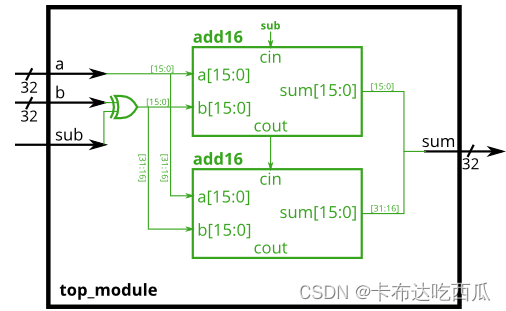本文主要是介绍Verilog刷题[hdlbits] :Module addsub,希望对大家解决编程问题提供一定的参考价值,需要的开发者们随着小编来一起学习吧!
题目:Module addsub
An adder-subtractor can be built from an adder by optionally negating one of the inputs, which is equivalent to inverting the input then adding 1. The net result is a circuit that can do two operations: (a + b + 0) and (a + ~b + 1). See Wikipedia if you want a more detailed explanation of how this circuit works.
- 加法器-减法器可以由加法器通过选择性地对其中一个输入求反来构建,这相当于对输入求反然后加1。最终结果是一个可以进行两个运算的电路:(a+b+0)和(a+~b+1)。如果你想更详细地解释这个电路是如何工作的,请参阅维基百科。
Build the adder-subtractor below.
- 构建下面的加减法器。
You are provided with a 16-bit adder module, which you need to instantiate twice:
- 为您提供了一个16位加法器模块,您需要实例化两次:
module add16 ( input[15:0] a, input[15:0] b, input cin, output[15:0] sum, output cout );
Use a 32-bit wide XOR gate to invert the b input whenever sub is 1. (This can also be viewed as b[31:0] XORed with sub replicated 32 times. See replication operator.). Also connect the sub input to the carry-in of the adder.
- 每当sub为1时,使用32位宽的XOR门来反转b输入。(这也可以被视为b[31:0]与子复制进行32次异或。请参阅复制运算符。)也可以将子输入连接到加法器的进位。

该题目实现较为简单,题目中也给出了可以通过前面章节学习的复制将sub进行扩展,但该题目需要理解为什么通过异或与设置cin位为sub就能够将加法器改造为减法器。B站Up主视频讲解了计算机能够通过补码完成加减法运算。
因此,在进行减法运算时,需要将被减数b的补码变为-b的补码,视频中讲解了可以将每一位均取反再加+1。当sub为1,完成位扩展后变为32个1。此时,再与b进行异或操作(不相同为1,相同为0),即可完成取反,在结合sub的进位即可完成b的补码变为-b的补码。通过a+(-b)的补码完成取反操作。
同时,当sub为0是,b异或后不变,且进位cin为0,与原来的加法器一样。
module top_module(input [31:0] a,input [31:0] b,input sub,output [31:0] sum
);//进位信号wire cout;wire [31:0] b_xor;assign b_xor = {32{sub}} ^ b;//低16位相加add16 add16_init_0( .a(a[15:0]), .b(b_xor[15:0]),.cin(sub), .sum(sum[15:0]), .cout(cout) );//高16位相加add16 add16_init_2( .a(a[31:16]), .b(b_xor[31:16]),.cin(cout), .sum(sum[31:16]),.cout() );endmodule这篇关于Verilog刷题[hdlbits] :Module addsub的文章就介绍到这儿,希望我们推荐的文章对编程师们有所帮助!







